Draw One Planar Structure Each for the Following
Affiliate twenty. Organic Chemistry
twenty.i Hydrocarbons
Learning Objectives
Past the end of this section, yous will exist able to:
- Explain the importance of hydrocarbons and the reason for their diversity
- Name saturated and unsaturated hydrocarbons, and molecules derived from them
- Describe the reactions characteristic of saturated and unsaturated hydrocarbons
- Identify structural and geometric isomers of hydrocarbons
The largest database[1] of organic compounds lists about 10 one thousand thousand substances, which include compounds originating from living organisms and those synthesized by chemists. The number of potential organic compounds has been estimated[ii] at 1060—an astronomically loftier number. The beingness of and then many organic molecules is a consequence of the power of carbon atoms to course up to four strong bonds to other carbon atoms, resulting in chains and rings of many dissimilar sizes, shapes, and complexities.
The simplest organic compounds incorporate only the elements carbon and hydrogen, and are called hydrocarbons. Even though they are composed of only two types of atoms, there is a broad variety of hydrocarbons because they may consist of varying lengths of bondage, branched chains, and rings of carbon atoms, or combinations of these structures. In improver, hydrocarbons may differ in the types of carbon-carbon bonds nowadays in their molecules. Many hydrocarbons are found in plants, animals, and their fossils; other hydrocarbons have been prepared in the laboratory. We utilise hydrocarbons every day, mainly equally fuels, such every bit natural gas, acetylene, propane, butane, and the principal components of gasoline, diesel fuel fuel, and heating oil. The familiar plastics polyethylene, polypropylene, and polystyrene are as well hydrocarbons. We can distinguish several types of hydrocarbons past differences in the bonding between carbon atoms. This leads to differences in geometries and in the hybridization of the carbon orbitals.
Alkanes
Alkanes, or saturated hydrocarbons, incorporate merely single covalent bonds between carbon atoms. Each of the carbon atoms in an methane series has sp 3 hybrid orbitals and is bonded to four other atoms, each of which is either carbon or hydrogen. The Lewis structures and models of methane, ethane, and pentane are illustrated in Figure 1. Carbon chains are usually drawn as straight lines in Lewis structures, simply one has to remember that Lewis structures are non intended to indicate the geometry of molecules. Notice that the carbon atoms in the structural models (the ball-and-stick and space-filling models) of the pentane molecule do not lie in a straight line. Considering of the sp iii hybridization, the bond angles in carbon chains are close to 109.v°, giving such chains in an alkane a zigzag shape.
The structures of alkanes and other organic molecules may also be represented in a less detailed manner by condensed structural formulas (or simply, condensed formulas). Instead of the usual format for chemical formulas in which each chemical element symbol appears just once, a condensed formula is written to suggest the bonding in the molecule. These formulas have the appearance of a Lewis structure from which most or all of the bond symbols take been removed. Condensed structural formulas for ethane and pentane are shown at the bottom of Figure 1, and several additional examples are provided in the exercises at the cease of this chapter.
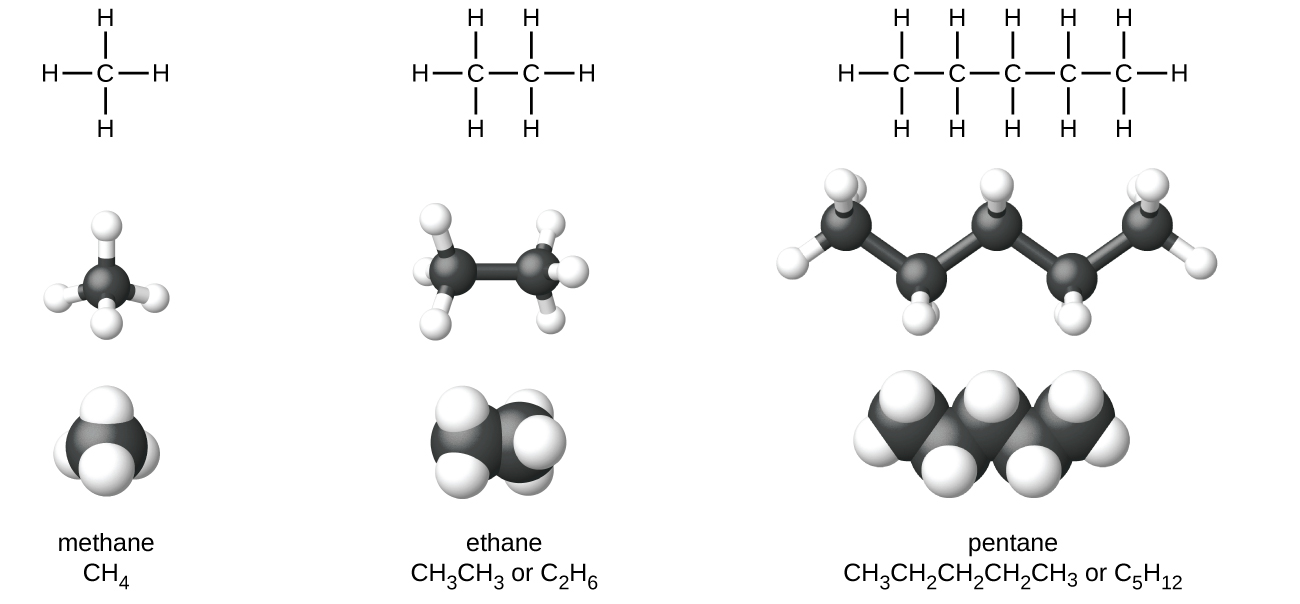
A mutual method used by organic chemists to simplify the drawings of larger molecules is to use a skeletal construction (also called a line-angle structure). In this type of construction, carbon atoms are non symbolized with a C, but represented by each stop of a line or bend in a line. Hydrogen atoms are not fatigued if they are attached to a carbon. Other atoms as well carbon and hydrogen are represented past their elemental symbols. Figure 2 shows three dissimilar ways to draw the aforementioned structure.
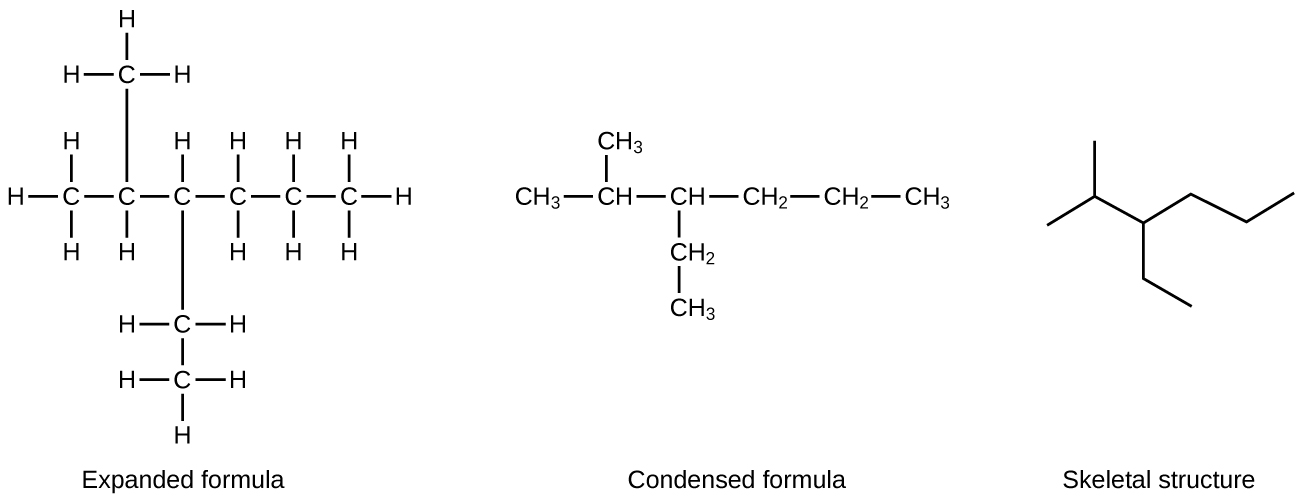
Example 1
Drawing Skeletal Structures
Draw the skeletal structures for these two molecules:

Solution
Each carbon atom is converted into the end of a line or the identify where lines intersect. All hydrogen atoms attached to the carbon atoms are left out of the structure (although nosotros notwithstanding need to recognize they are at that place):

Check Your Learning
Depict the skeletal structures for these two molecules:
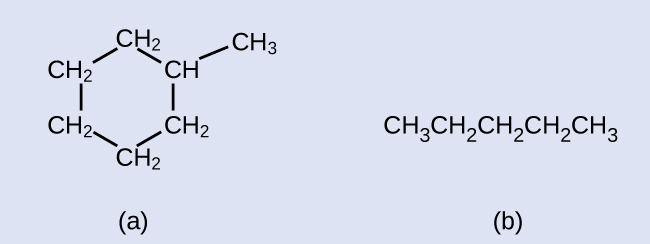
Answer:

Example two
Interpreting Skeletal Structures
Place the chemical formula of the molecule represented hither:
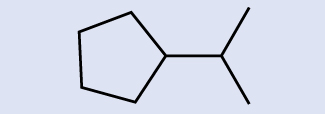
Solution
There are viii places where lines intersect or end, significant that there are eight carbon atoms in the molecule. Since we know that carbon atoms tend to make four bonds, each carbon atom will have the number of hydrogen atoms that are required for 4 bonds. This compound contains 16 hydrogen atoms for a molecular formula of C8H16.
Location of the hydrogen atoms:

Check Your Learning
Place the chemical formula of the molecule represented here:
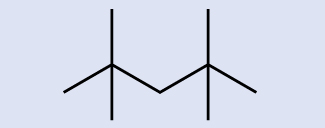
All alkanes are composed of carbon and hydrogen atoms, and have similar bonds, structures, and formulas; noncyclic alkanes all have a formula of CnorthH2n+2. The number of carbon atoms present in an alkane has no limit. Greater numbers of atoms in the molecules volition atomic number 82 to stronger intermolecular attractions (dispersion forces) and correspondingly dissimilar physical properties of the molecules. Properties such equally melting point and humid point (Table 1) normally change smoothly and predictably as the number of carbon and hydrogen atoms in the molecules change.
| Alkane | Molecular Formula | Melting Point (°C) | Boiling Point (°C) | Phase at STP[3] | Number of Structural Isomers |
|---|---|---|---|---|---|
| methane | CH4 | –182.five | –161.five | gas | 1 |
| ethane | C2Hhalf dozen | –183.3 | –88.6 | gas | 1 |
| propane | C3Hviii | –187.7 | –42.i | gas | ane |
| butane | C4H10 | –138.3 | –0.5 | gas | two |
| pentane | C5H12 | –129.7 | 36.1 | liquid | three |
| hexane | CviH14 | –95.iii | 68.vii | liquid | 5 |
| heptane | C7H16 | –xc.six | 98.iv | liquid | ix |
| octane | C8Heighteen | –56.8 | 125.7 | liquid | 18 |
| nonane | CnineH20 | –53.6 | 150.8 | liquid | 35 |
| decane | C10H22 | –29.7 | 174.0 | liquid | 75 |
| tetradecane | C14H30 | five.nine | 253.v | solid | 1858 |
| octadecane | C18H38 | 28.2 | 316.1 | solid | sixty,523 |
| Table 1. Properties of Some Alkanes[4] | |||||
Hydrocarbons with the aforementioned formula, including alkanes, can have different structures. For example, 2 alkanes take the formula CivH10: They are called n-butane and 2-methylpropane (or isobutane), and take the following Lewis structures:

The compounds n-butane and 2-methylpropane are structural isomers (the term constitutional isomers is also commonly used). Constitutional isomers accept the same molecular formula merely different spatial arrangements of the atoms in their molecules. The n-butane molecule contains an unbranched chain, meaning that no carbon cantlet is bonded to more than two other carbon atoms. We employ the term normal, or the prefix n, to refer to a chain of carbon atoms without branching. The compound 2–methylpropane has a branched chain (the carbon atom in the center of the Lewis structure is bonded to three other carbon atoms)
Identifying isomers from Lewis structures is not equally like shooting fish in a barrel every bit it looks. Lewis structures that await different may actually correspond the same isomers. For case, the iii structures in Figure 3 all represent the aforementioned molecule, n-butane, and hence are not different isomers. They are identical because each contains an unbranched chain of 4 carbon atoms.

The Basics of Organic Nomenclature: Naming Alkanes
The International Union of Pure and Applied Chemistry (IUPAC) has devised a arrangement of classification that begins with the names of the alkanes and can be adjusted from there to account for more complicated structures. The nomenclature for alkanes is based on two rules:
- To proper name an methane series, commencement identify the longest chain of carbon atoms in its structure. A ii-carbon chain is called ethane; a three-carbon chain, propane; and a four-carbon chain, butane. Longer chains are named every bit follows: pentane (five-carbon chain), hexane (6), heptane (7), octane (8), nonane (9), and decane (10). These prefixes tin be seen in the names of the alkanes described in Table ane.
- Add together prefixes to the proper name of the longest chain to bespeak the positions and names of substituents. Substituents are branches or functional groups that replace hydrogen atoms on a chain. The position of a substituent or branch is identified by the number of the carbon atom information technology is bonded to in the concatenation. We number the carbon atoms in the chain by counting from the finish of the concatenation nearest the substituents. Multiple substituents are named individually and placed in alphabetical guild at the front end of the proper noun.

When more than one substituent is present, either on the same carbon atom or on different carbon atoms, the substituents are listed alphabetically. Because the carbon atom numbering begins at the end closest to a substituent, the longest chain of carbon atoms is numbered in such a manner as to produce the everyman number for the substituents. The ending -o replaces -ide at the finish of the name of an electronegative substituent (in ionic compounds, the negatively charged ion ends with -ide similar chloride; in organic compounds, such atoms are treated as substituents and the -o ending is used). The number of substituents of the same type is indicated by the prefixes di- (2), tri- (iii), tetra- (4), and then on (for example, difluoro- indicates two fluoride substituents).
Example 3
Naming Element of group vii-substituted Alkanes
Proper noun the molecule whose structure is shown here:
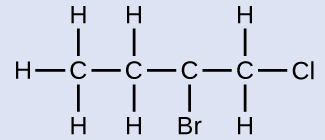
Solution
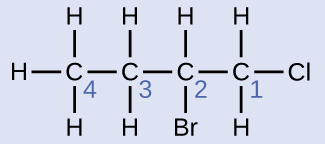
The four-carbon chain is numbered from the end with the chlorine atom. This puts the substituents on positions i and 2 (numbering from the other end would put the substituents on positions three and 4). Iv carbon atoms ways that the base name of this compound will be butane. The bromine at position 2 volition be described by adding 2-bromo-; this will come at the offset of the name, since bromo- comes before chloro- alphabetically. The chlorine at position 1 will be described by adding 1-chloro-, resulting in the name of the molecule being 2-bromo-i-chlorobutane.
Cheque Your Learning
Proper noun the following molecule:

Answer:
3,three-dibromo-ii-iodopentane
We call a substituent that contains one less hydrogen than the respective alkane an alkyl grouping. The name of an alkyl group is obtained by dropping the suffix -1 of the methane series name and calculation -yl:

The open bonds in the methyl and ethyl groups indicate that these alkyl groups are bonded to another atom.
Case four
Naming Substituted Alkanes
Name the molecule whose construction is shown here:
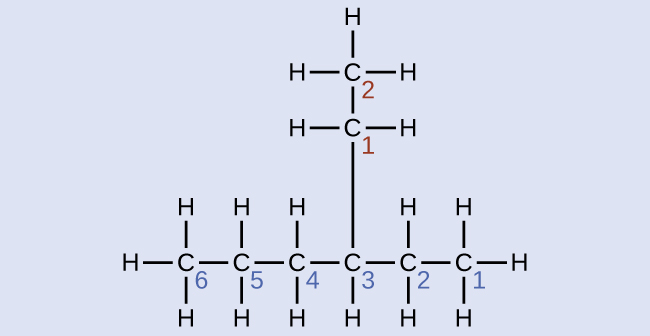
Solution
The longest carbon chain runs horizontally across the page and contains six carbon atoms (this makes the base of operations of the name hexane, but we volition likewise need to incorporate the proper noun of the co-operative). In this instance, we want to number from right to left (as shown by the blue numbers) and so the branch is connected to carbon 3 (imagine the numbers from left to right—this would put the branch on carbon 4, violating our rules). The branch attached to position three of our chain contains two carbon atoms (numbered in cerise)—then we take our name for two carbons eth- and attach -yl at the end to signify we are describing a co-operative. Putting all the pieces together, this molecule is 3-ethylhexane.
Check Your Learning
Name the following molecule:

Some hydrocarbons can grade more than than one type of alkyl group when the hydrogen atoms that would be removed have different "environments" in the molecule. This diversity of possible alkyl groups can be identified in the following way: The iv hydrogen atoms in a methane molecule are equivalent; they all have the same environment. They are equivalent because each is bonded to a carbon atom (the aforementioned carbon atom) that is bonded to three hydrogen atoms. (It may be easier to see the equivalency in the ball and stick models in Figure 1. Removal of any 1 of the four hydrogen atoms from methyl hydride forms a methyl group. Likewise, the half-dozen hydrogen atoms in ethane are equivalent (Figure 1) and removing whatsoever one of these hydrogen atoms produces an ethyl group. Each of the six hydrogen atoms is bonded to a carbon atom that is bonded to ii other hydrogen atoms and a carbon atom. Nonetheless, in both propane and ii–methylpropane, there are hydrogen atoms in two different environments, distinguished by the adjacent atoms or groups of atoms:

Each of the six equivalent hydrogen atoms of the first type in propane and each of the nine equivalent hydrogen atoms of that blazon in ii-methylpropane (all shown in black) are bonded to a carbon cantlet that is bonded to only ane other carbon atom. The two purple hydrogen atoms in propane are of a second type. They differ from the six hydrogen atoms of the kickoff blazon in that they are bonded to a carbon atom bonded to two other carbon atoms. The light-green hydrogen atom in 2-methylpropane differs from the other nine hydrogen atoms in that molecule and from the purple hydrogen atoms in propane. The greenish hydrogen cantlet in ii-methylpropane is bonded to a carbon atom bonded to iii other carbon atoms. Two different alkyl groups tin can exist formed from each of these molecules, depending on which hydrogen atom is removed. The names and structures of these and several other alkyl groups are listed in Figure 4.
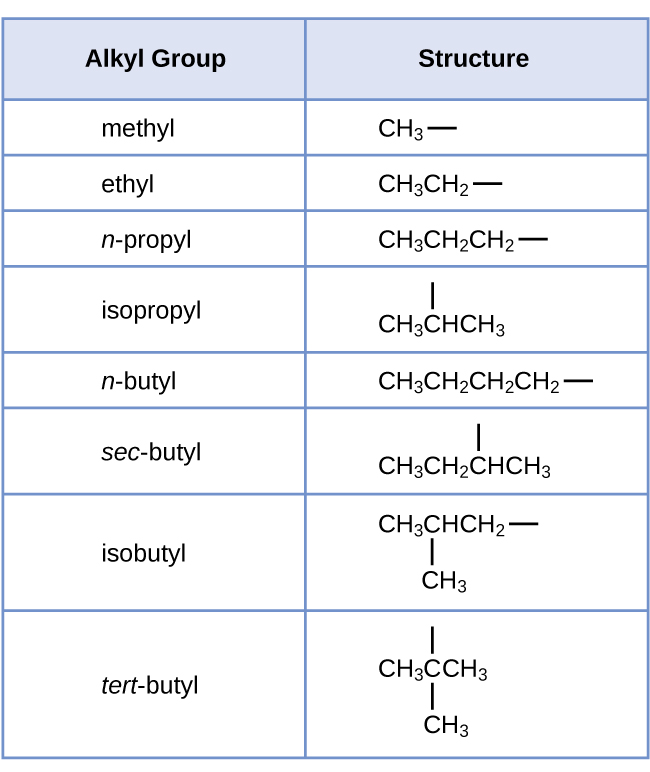
Note that alkyl groups do not exist as stable independent entities. They are always a office of some larger molecule. The location of an alkyl grouping on a hydrocarbon chain is indicated in the same manner as any other substituent:

Alkanes are relatively stable molecules, but heat or light will activate reactions that involve the breaking of C–H or C–C single bonds. Combustion is i such reaction:
[latex]\text{CH}_4(chiliad)\;+\;2\text{O}_2(g)\;{\longrightarrow}\;\text{CO}_2(g)\;+\;ii\text{H}_2\text{O}(1000)[/latex]
Alkanes fire in the presence of oxygen, a highly exothermic oxidation-reduction reaction that produces carbon dioxide and water. As a consequence, alkanes are splendid fuels. For instance, methane, CH4, is the principal component of natural gas. Butane, CivH10, used in camping stoves and lighters is an alkane. Gasoline is a liquid mixture of continuous- and branched-chain alkanes, each containing from five to 9 carbon atoms, plus various additives to improve its performance as a fuel. Kerosene, diesel oil, and fuel oil are primarily mixtures of alkanes with higher molecular masses. The primary source of these liquid alkane series fuels is crude oil, a complex mixture that is separated by partial distillation. Partial distillation takes advantage of differences in the boiling points of the components of the mixture (see Figure five). You may remember that boiling point is a function of intermolecular interactions, which was discussed in the affiliate on solutions and colloids.
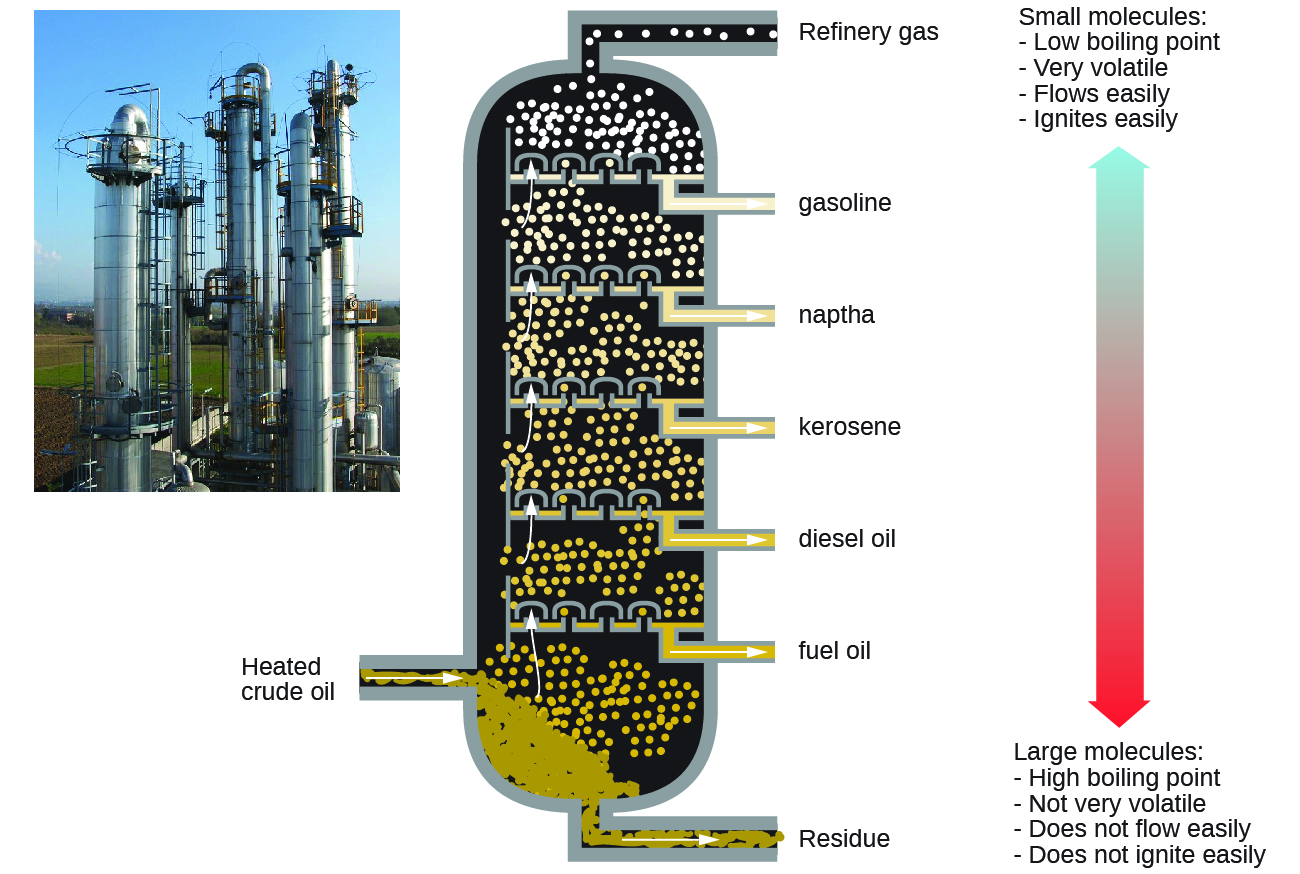
In a substitution reaction, another typical reaction of alkanes, ane or more than of the methane series's hydrogen atoms is replaced with a different cantlet or group of atoms. No carbon-carbon bonds are broken in these reactions, and the hybridization of the carbon atoms does not change. For case, the reaction between ethane and molecular chlorine depicted hither is a substitution reaction:

The C–Cl portion of the chloroethane molecule is an example of a functional group, the role or moiety of a molecule that imparts a specific chemical reactivity. The types of functional groups present in an organic molecule are major determinants of its chemical properties and are used as a means of classifying organic compounds every bit detailed in the remaining sections of this affiliate.

Want more than practice naming alkanes? Watch this brief video tutorial to review the nomenclature process.
Alkenes
Organic compounds that contain one or more double or triple bonds between carbon atoms are described as unsaturated. Y'all have probable heard of unsaturated fats. These are complex organic molecules with long bondage of carbon atoms, which comprise at to the lowest degree ane double bail between carbon atoms. Unsaturated hydrocarbon molecules that contain one or more double bonds are called alkenes. Carbon atoms linked by a double bail are leap together by 2 bonds, i σ bond and ane π bond. Double and triple bonds give rising to a different geometry effectually the carbon atom that participates in them, leading to of import differences in molecular shape and properties. The differing geometries are responsible for the different properties of unsaturated versus saturated fats.
Ethene, C2Hiv, is the simplest alkene. Each carbon atom in ethene, usually called ethylene, has a trigonal planar construction. The second member of the series is propene (propylene) (Figure half dozen); the butene isomers follow in the series. 4 carbon atoms in the chain of butene allows for the formation of isomers based on the position of the double bail, equally well as a new form of isomerism.
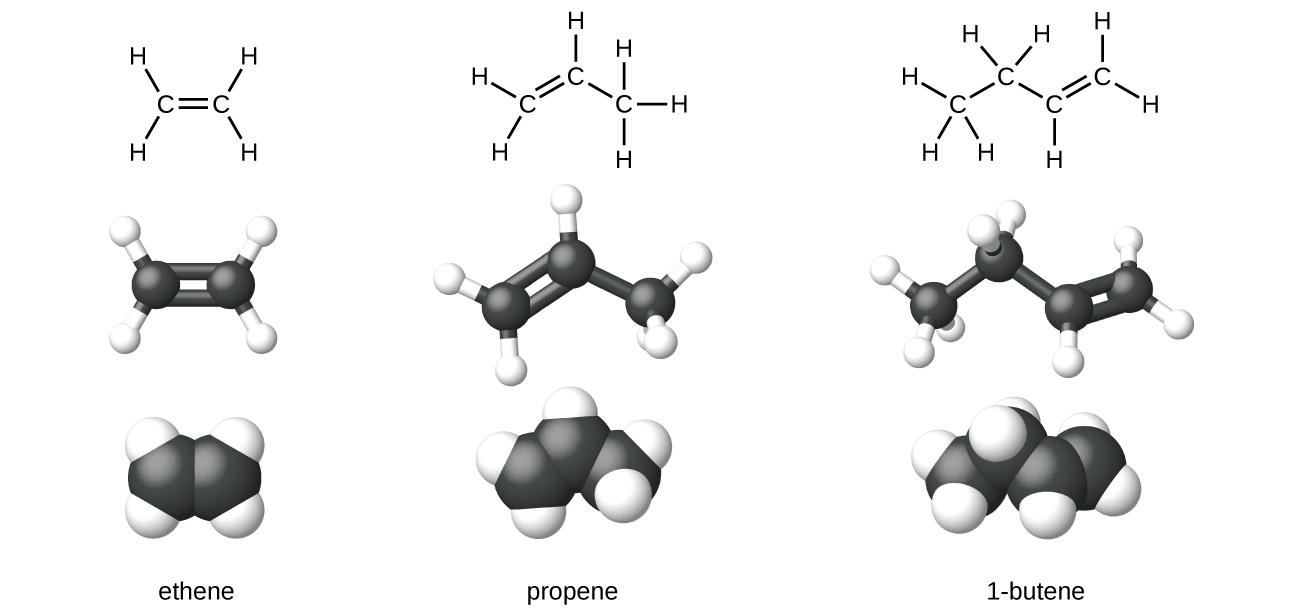
Ethylene (the mutual industrial proper noun for ethene) is a basic raw material in the product of polyethylene and other important compounds. Over 135 million tons of ethylene were produced worldwide in 2010 for use in the polymer, petrochemical, and plastic industries. Ethylene is produced industrially in a process chosen corking, in which the long hydrocarbon bondage in a petroleum mixture are broken into smaller molecules.
Recycling Plastics
Polymers (from Greek words poly pregnant "many" and mer meaning "parts") are big molecules made upwards of repeating units, referred to as monomers. Polymers tin can exist natural (starch is a polymer of sugar residues and proteins are polymers of amino acids) or synthetic [like polyethylene, polyvinyl chloride (PVC), and polystyrene]. The diversity of structures of polymers translates into a broad range of properties and uses that make them integral parts of our everyday lives. Adding functional groups to the structure of a polymer can effect in significantly unlike backdrop (encounter the discussion about Kevlar after in this chapter).
An instance of a polymerization reaction is shown in Figure seven. The monomer ethylene (C2H4) is a gas at room temperature, but when polymerized, using a transition metal catalyst, information technology is transformed into a solid cloth made up of long chains of –CH2– units called polyethylene. Polyethylene is a commodity plastic used primarily for packaging (bags and films).
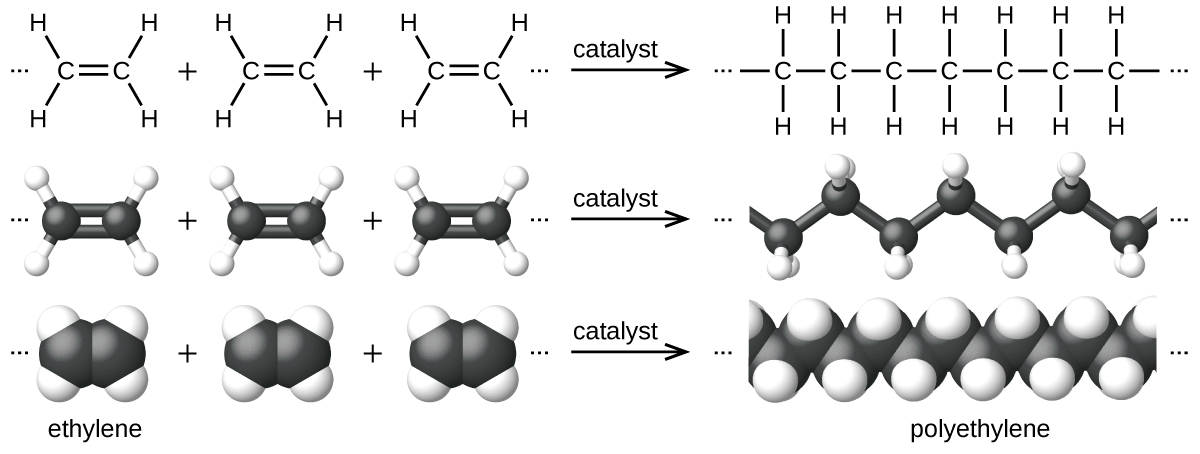
Polyethylene is a fellow member of one subset of synthetic polymers classified as plastics. Plastics are constructed organic solids that tin can be molded; they are typically organic polymers with loftier molecular masses. Virtually of the monomers that go into mutual plastics (ethylene, propylene, vinyl chloride, styrene, and ethylene terephthalate) are derived from petrochemicals and are not very biodegradable, making them candidate materials for recycling. Recycling plastics helps minimize the need for using more of the petrochemical supplies and also minimizes the environmental damage acquired by throwing away these nonbiodegradable materials.
Plastic recycling is the process of recovering waste, scrap, or used plastics, and reprocessing the material into useful products. For case, polyethylene terephthalate (soft drink bottles) can exist melted downwardly and used for plastic furniture, in carpets, or for other applications. Other plastics, like polyethylene (bags) and polypropylene (cups, plastic food containers), can be recycled or reprocessed to exist used over again. Many areas of the country accept recycling programs that focus on 1 or more of the article plastics that have been assigned a recycling code (see Figure viii). These operations have been in effect since the 1970s and have made the production of some plastics among the about efficient industrial operations today.
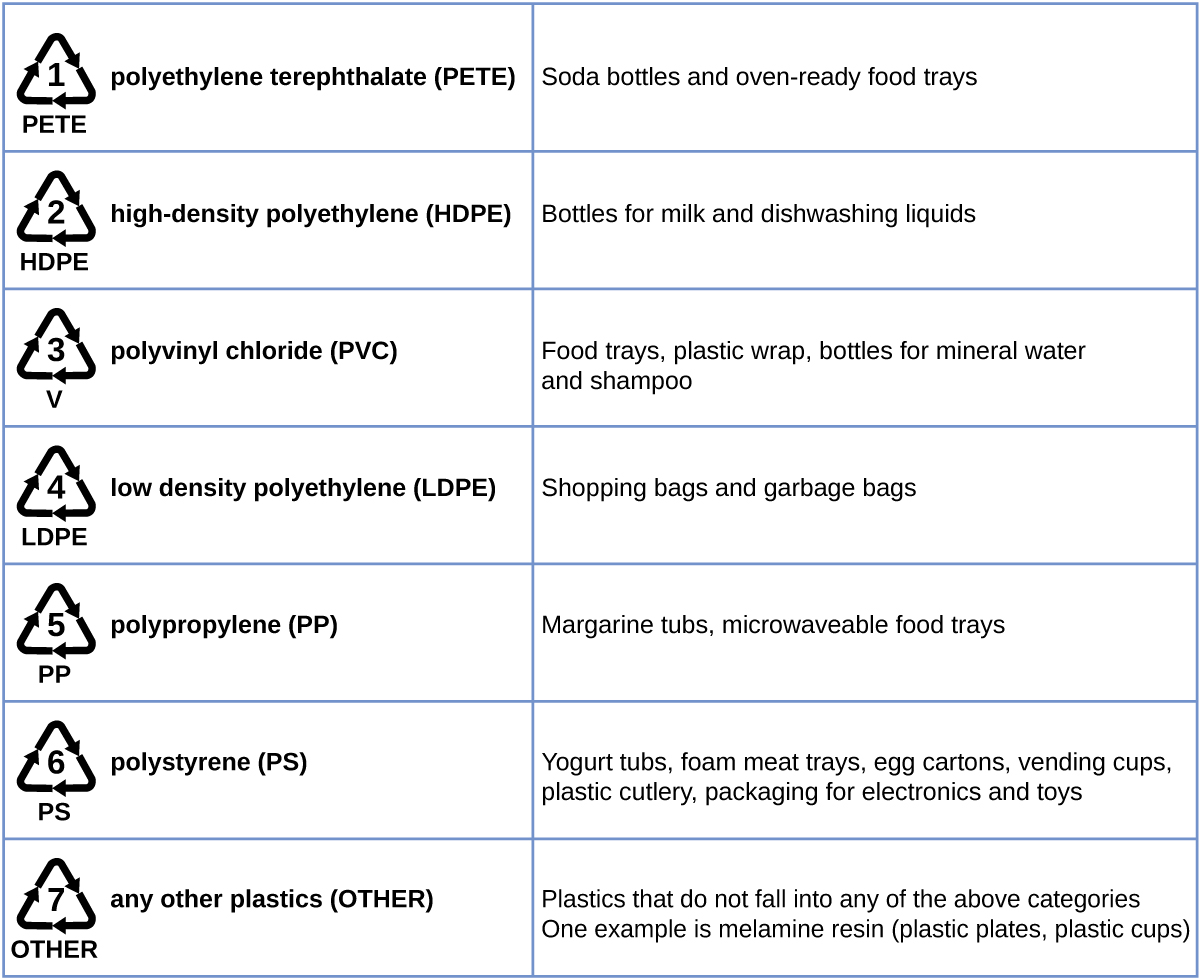
The name of an alkene is derived from the name of the alkane with the same number of carbon atoms. The presence of the double bond is signified by replacing the suffix -ane with the suffix -ene. The location of the double bond is identified by naming the smaller of the numbers of the carbon atoms participating in the double bond:

Isomers of Alkenes
Molecules of 1-butene and 2-butene are structural isomers; the arrangement of the atoms in these ii molecules differs. As an instance of arrangement differences, the offset carbon atom in 1-butene is bonded to two hydrogen atoms; the first carbon atom in 2-butene is bonded to three hydrogen atoms.
The chemical compound two-butene and some other alkenes also grade a second blazon of isomer called a geometric isomer. In a set of geometric isomers, the aforementioned types of atoms are attached to each other in the aforementioned club, only the geometries of the two molecules differ. Geometric isomers of alkenes differ in the orientation of the groups on either side of a [latex]\text{C}\;=\;\text{C}[/latex] bond.
Carbon atoms are free to rotate around a single bail just not around a double bail; a double bond is rigid. This makes it possible to have 2 isomers of ii-butene, one with both methyl groups on the aforementioned side of the double bond and one with the methyl groups on opposite sides. When structures of butene are drawn with 120° bond angles around the sp ii-hybridized carbon atoms participating in the double bond, the isomers are apparent. The ii-butene isomer in which the two methyl groups are on the same side is chosen a cis-isomer; the ane in which the two methyl groups are on reverse sides is called a trans-isomer (Figure 9). The dissimilar geometries produce different physical backdrop, such as humid point, that may brand separation of the isomers possible:
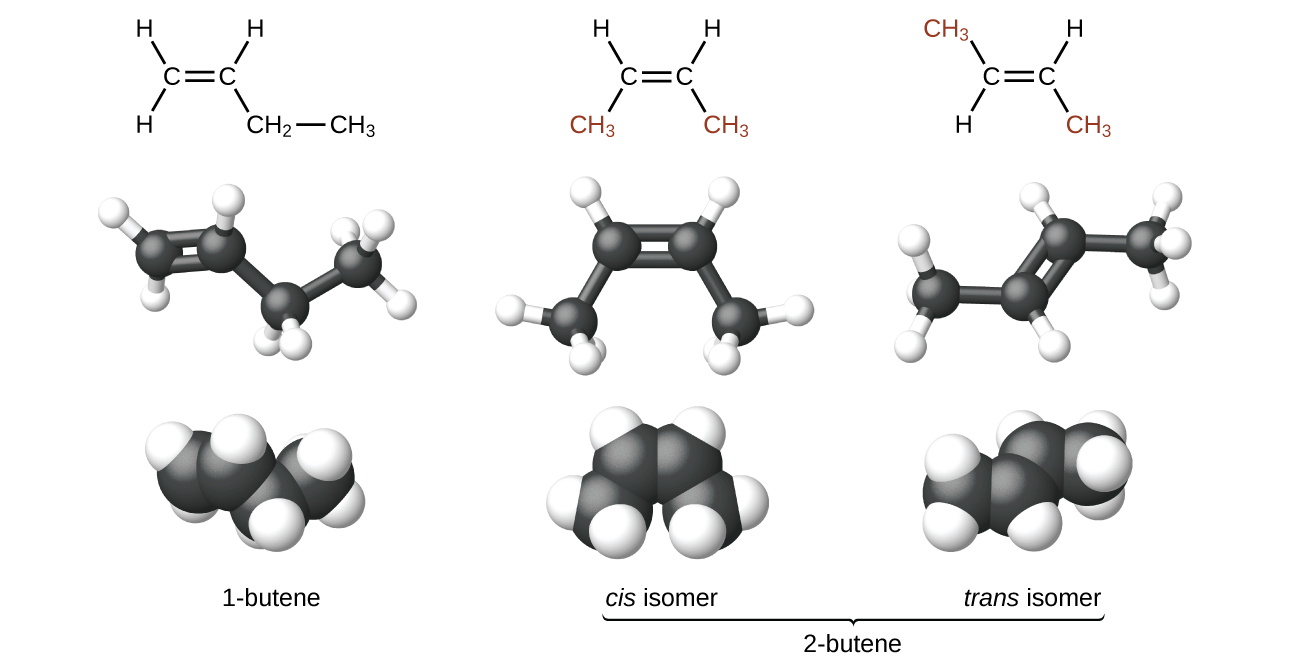
Alkenes are much more reactive than alkanes because the [latex]\text{C}\;=\;\text{C}[/latex] moiety is a reactive functional group. A π bond, being a weaker bond, is disrupted much more easily than a σ bail. Thus, alkenes undergo a characteristic reaction in which the π bond is cleaved and replaced by two σ bonds. This reaction is called an addition reaction. The hybridization of the carbon atoms in the double bail in an alkene changes from sp two to sp three during an addition reaction. For case, halogens add to the double bond in an alkene instead of replacing hydrogen, as occurs in an alkane:

Example v
Alkene Reactivity and Naming
Provide the IUPAC names for the reactant and product of the halogenation reaction shown hither:

Solution
The reactant is a five-carbon chain that contains a carbon-carbon double bond, so the base proper name volition be pentene. Nosotros begin counting at the end of the chain closest to the double bond—in this example, from the left—the double bail spans carbons 2 and 3, so the name becomes 2-pentene. Since there are two carbon-containing groups fastened to the two carbon atoms in the double bail—and they are on the same side of the double bond—this molecule is the cis-isomer, making the name of the starting alkene cis-ii-pentene. The product of the halogenation reaction will have two chlorine atoms fastened to the carbon atoms that were a part of the carbon-carbon double bond:
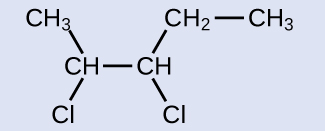
This molecule is now a substituted alkane and will be named equally such. The base of the proper name volition exist pentane. We will count from the cease that numbers the carbon atoms where the chlorine atoms are attached every bit 2 and three, making the name of the product 2,iii-dichloropentane.
Check Your Learning
Provide names for the reactant and product of the reaction shown:

Answer:
reactant: cis-3-hexene production: 3,four-dichlorohexane
Alkynes
Hydrocarbon molecules with 1 or more triple bonds are called alkynes; they make upwards another serial of unsaturated hydrocarbons. Two carbon atoms joined by a triple bail are spring together past ane σ bond and two π bonds. The sp-hybridized carbons involved in the triple bond have bond angles of 180°, giving these types of bonds a linear, rod-like shape.
The simplest fellow member of the alkyne series is ethyne, CiiH2, commonly called acetylene. The Lewis construction for ethyne, a linear molecule, is:

The IUPAC nomenclature for alkynes is similar to that for alkenes except that the suffix -yne is used to point a triple bond in the chain. For example, [latex]\text{CH}_3\text{CH}_2\text{C}\;{\equiv}\;\text{CH}[/latex] is called 1-butyne.
Example six
Structure of Alkynes
Describe the geometry and hybridization of the carbon atoms in the post-obit molecule:

Solution
Carbon atoms one and 4 accept four single bonds and are thus tetrahedral with sp three hybridization. Carbon atoms 2 and 3 are involved in the triple bail, so they accept linear geometries and would be classified as sp hybrids.
Cheque Your Learning
Identify the hybridization and bond angles at the carbon atoms in the molecule shown:

Answer:
carbon 1: sp, 180°; carbon 2: sp, 180°; carbon 3: sp ii, 120°; carbon 4: sp 2, 120°; carbon 5: sp 3, 109.5°
Chemically, the alkynes are similar to the alkenes. Since the [latex]\text{C}\;{\equiv}\;\text{C}[/latex] functional group has ii π bonds, alkynes typically react even more readily, and react with twice every bit much reagent in addition reactions. The reaction of acetylene with bromine is a typical case:

Acetylene and the other alkynes likewise burn readily. An acetylene torch takes reward of the high heat of combustion for acetylene.
Aromatic Hydrocarbons
Benzene, C6Hsix, is the simplest member of a big family of hydrocarbons, called effluvious hydrocarbons. These compounds contain band structures and showroom bonding that must be described using the resonance hybrid concept of valence bail theory or the delocalization concept of molecular orbital theory. (To review these concepts, refer to the earlier chapters on chemic bonding). The resonance structures for benzene, C6H6, are:
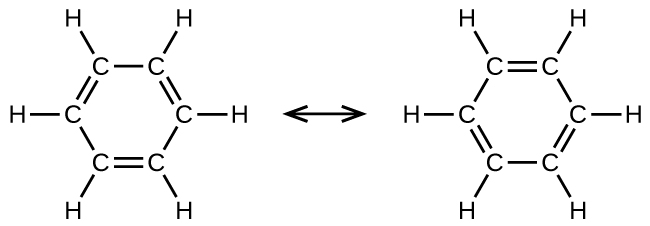
Valence bail theory describes the benzene molecule and other planar effluvious hydrocarbon molecules as hexagonal rings of sp two-hybridized carbon atoms with the unhybridized p orbital of each carbon atom perpendicular to the airplane of the ring. Three valence electrons in the sp two hybrid orbitals of each carbon atom and the valence electron of each hydrogen atom form the framework of σ bonds in the benzene molecule. The fourth valence electron of each carbon atom is shared with an adjacent carbon cantlet in their unhybridized p orbitals to yield the π bonds. Benzene does not, yet, exhibit the characteristics typical of an alkene. Each of the six bonds betwixt its carbon atoms is equivalent and exhibits properties that are intermediate betwixt those of a C–C unmarried bond and a [latex]\text{C}\;=\;\text{C}[/latex] double bail. To represent this unique bonding, structural formulas for benzene and its derivatives are typically drawn with unmarried bonds between the carbon atoms and a circle inside the ring equally shown in Effigy x.

There are many derivatives of benzene. The hydrogen atoms tin exist replaced by many unlike substituents. Aromatic compounds more than readily undergo substitution reactions than addition reactions; replacement of one of the hydrogen atoms with another substituent will leave the delocalized double bonds intact. The following are typical examples of substituted benzene derivatives:

Toluene and xylene are important solvents and raw materials in the chemical industry. Styrene is used to produce the polymer polystyrene.
Example seven
Structure of Aromatic Hydrocarbons
1 possible isomer created by a substitution reaction that replaces a hydrogen atom attached to the aromatic band of toluene with a chlorine cantlet is shown here. Draw two other possible isomers in which the chlorine atom replaces a different hydrogen cantlet attached to the aromatic ring:
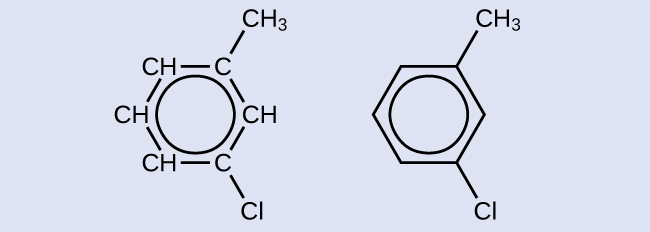
Solution
Since the six-carbon ring with alternate double bonds is necessary for the molecule to be classified every bit aromatic, appropriate isomers tin exist produced only by irresolute the positions of the chloro-substituent relative to the methyl-substituent:

Check Your Learning
Depict three isomers of a half-dozen-membered effluvious ring compound substituted with two bromines.
Answer:
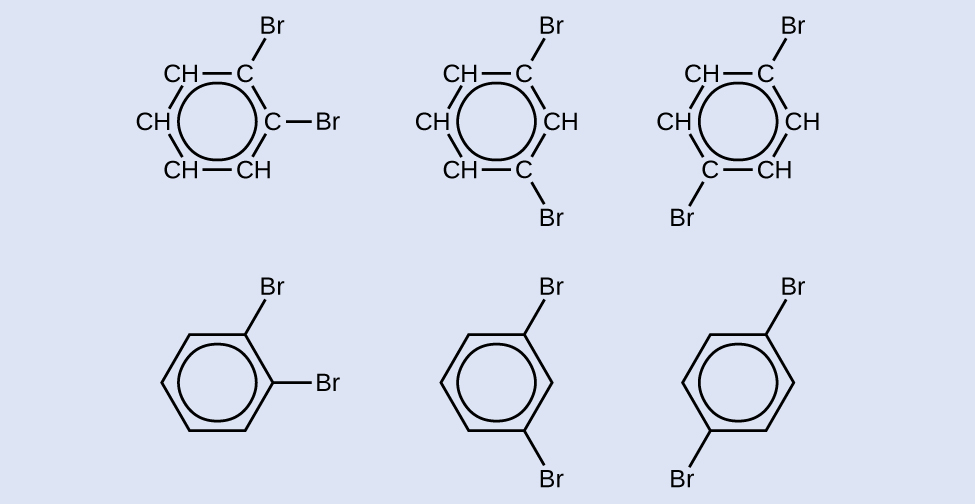
Cardinal Concepts and Summary
Potent, stable bonds between carbon atoms produce complex molecules containing chains, branches, and rings. The chemistry of these compounds is chosen organic chemistry. Hydrocarbons are organic compounds equanimous of only carbon and hydrogen. The alkanes are saturated hydrocarbons—that is, hydrocarbons that contain only single bonds. Alkenes contain one or more carbon-carbon double bonds. Alkynes comprise one or more carbon-carbon triple bonds. Effluvious hydrocarbons contain band structures with delocalized π electron systems.
Chemistry Stop of Chapter Exercises
- Write the chemical formula and Lewis structure of the following, each of which contains five carbon atoms:
(a) an alkane
(b) an alkene
(c) an alkyne
- What is the difference between the hybridization of carbon atoms' valence orbitals in saturated and unsaturated hydrocarbons?
- On a microscopic level, how does the reaction of bromine with a saturated hydrocarbon differ from its reaction with an unsaturated hydrocarbon? How are they similar?
- On a microscopic level, how does the reaction of bromine with an alkene differ from its reaction with an alkyne? How are they similar?
- Explain why unbranched alkenes tin can form geometric isomers while unbranched alkanes cannot. Does this explanation involve the macroscopic domain or the microscopic domain?
- Explain why these two molecules are non isomers:

- Explain why these ii molecules are non isomers:

- How does the carbon-atom hybridization change when polyethylene is prepared from ethylene?
- Write the Lewis structure and molecular formula for each of the post-obit hydrocarbons:
(a) hexane
(b) 3-methylpentane
(c) cis-three-hexene
(d) four-methyl-one-pentene
(e) three-hexyne
(f) 4-methyl-2-pentyne
- Write the chemical formula, condensed formula, and Lewis structure for each of the following hydrocarbons:
(a) heptane
(b) 3-methylhexane
(c) trans-3-heptene
(d) iv-methyl-1-hexene
(due east) ii-heptyne
(f) three,4-dimethyl-i-pentyne
- Give the consummate IUPAC name for each of the post-obit compounds:
(a) [latex]\text{CH}_3\text{CH}_2\text{CBr}_2\text{CH}_3[/latex]
(b) [latex](\text{CH}_3)_3\text{CCl}[/latex]
(c)

(d) [latex]\text{CH}_3\text{CH}_2\text{C}\;{\equiv}\;\text{CH\;CH}_3\text{CH}_2\text{C}\;{\equiv}\;\text{CH}[/latex]
(due east)

(f)

(g) [latex](\text{CH}_3)_2\text{CHCH}_2\text{CH} = \text{CH}_2[/latex]
- Give the complete IUPAC proper noun for each of the following compounds:
(a) [latex](\text{CH}_3)_2\text{CHF}[/latex]
(b) [latex]\text{CH}_3\text{CHClCHClCH}_3[/latex]
(c)

(d) [latex]\text{CH}_3\text{CH}_2\text{CH} = \text{CHCH}_3[/latex]
(e)

(f) [latex](\text{CH}_3)_3\text{CCH}_2\text{C}{\equiv}\text{CH}[/latex]
- Butane is used as a fuel in disposable lighters. Write the Lewis structure for each isomer of butane.
- Write Lewis structures and name the v structural isomers of hexane.
- Write Lewis structures for the cis–trans isomers of [latex]\text{CH}_3\text{CH} = \text{CHCl}[/latex].
- Write structures for the iii isomers of the aromatic hydrocarbon xylene, [latex]\text{C}_6\text{H}_4(\text{CH}_3)_2[/latex].
- Isooctane is the common name of the isomer of [latex]\text{C}_8\text{H}_18[/latex] used as the standard of 100 for the gasoline octane rating:

(a) What is the IUPAC proper noun for the compound?
(b) Name the other isomers that contain a five-carbon chain with iii methyl substituents.
- Write Lewis structures and IUPAC names for the alkyne isomers of [latex]\text{C}_4\text{H}_6[/latex].
- Write Lewis structures and IUPAC names for all isomers of [latex]\text{C}_4\text{H}_9\text{Cl}[/latex].
- Proper noun and write the structures of all isomers of the propyl and butyl alkyl groups.
- Write the structures for all the isomers of the [latex]-\text{C}_5\text{H}_{xi}[/latex] alkyl group.
- Write Lewis structures and describe the molecular geometry at each carbon atom in the following compounds:
(a) cis-3-hexene
(b) cis-1-chloro-ii-bromoethene
(c) 2-pentyne
(d) trans–6-ethyl-7-methyl-ii-octene
- Benzene is one of the compounds used equally an octane enhancer in unleaded gasoline. It is manufactured by the catalytic conversion of acetylene to benzene:[latex]3\text{C}_2\text{H}_2\;{\longrightarrow}\;\text{C}_6\text{H}_6[/latex]
Describe Lewis structures for these compounds, with resonance structures as advisable, and make up one's mind the hybridization of the carbon atoms in each.
- Teflon is prepared by the polymerization of tetrafluoroethylene. Write the equation that describes the polymerization using Lewis symbols.
- Write two complete, balanced equations for each of the post-obit reactions, one using condensed formulas and one using Lewis structures.
(a) 1 mol of 1-butyne reacts with 2 mol of iodine.
(b) Pentane is burned in air.
- Write 2 complete, counterbalanced equations for each of the post-obit reactions, one using condensed formulas and i using Lewis structures.
(a) 2-butene reacts with chlorine.
(b) benzene burns in air.
- What mass of two-bromopropane could exist prepared from 25.five g of propene? Assume a 100% yield of product.
- Acetylene is a very weak acrid; however, it will react with moist silver(I) oxide and form water and a compound composed of silver and carbon. Addition of a solution of HCl to a 0.2352-grand sample of the compound of silver and carbon produced acetylene and 0.2822 m of AgCl.
(a) What is the empirical formula of the compound of silverish and carbon?
(b) The production of acetylene on addition of HCl to the compound of silvery and carbon suggests that the carbon is present every bit the acetylide ion, [latex]\text{C}_2^{\;\;ii-}[/latex]. Write the formula of the compound showing the acetylide ion.
- Ethylene tin be produced by the pyrolysis of ethane:[latex]\text{C}_2\text{H}_6\;{\longrightarrow}\;\text{C}_2\text{H}_4\;+\;\text{H}_2[/latex]
How many kilograms of ethylene is produced by the pyrolysis of 1.000 × x3 kg of ethane, bold a 100.0% yield?
Glossary
- addition reaction
- reaction in which a double carbon-carbon bail forms a single carbon-carbon bond past the addition of a reactant. Typical reaction for an alkene.
- alkane
- molecule consisting of only carbon and hydrogen atoms continued by unmarried (σ) bonds
- alkene
- molecule consisting of carbon and hydrogen containing at least ane carbon-carbon double bond
- alkyl group
- substituent, consisting of an paraffin missing one hydrogen cantlet, fastened to a larger structure
- alkyne
- molecule consisting of carbon and hydrogen containing at to the lowest degree one carbon-carbon triple bond
- aromatic hydrocarbon
- cyclic molecule consisting of carbon and hydrogen with delocalized alternating carbon-carbon single and double bonds, resulting in enhanced stability
- functional group
- part of an organic molecule that imparts a specific chemical reactivity to the molecule
- organic compound
- natural or synthetic chemical compound that contains carbon
- saturated hydrocarbon
- molecule containing carbon and hydrogen that has just single bonds between carbon atoms
- skeletal structure
- shorthand method of cartoon organic molecules in which carbon atoms are represented past the ends of lines and bends in between lines, and hydrogen atoms attached to the carbon atoms are not shown (but are understood to be present past the context of the structure)
- substituent
- branch or functional group that replaces hydrogen atoms in a larger hydrocarbon chain
- substitution reaction
- reaction in which one atom replaces another in a molecule
Solutions
Answers to Chemistry Stop of Affiliate Exercises
one. There are several sets of answers; one is:
(a) [latex]\text{C}_5\text{H}_{12}[/latex]
 ;
;
(b) [latex]\text{C}_5\text{H}_{10}[/latex]
 ;
;
(c) [latex]\text{C}_5\text{H}_8[/latex]

iii. Both reactions result in bromine being incorporated into the construction of the product. The deviation is the style in which that incorporation takes place. In the saturated hydrocarbon, an existing C–H bond is broken, and a bond between the C and the Br can then be formed. In the unsaturated hydrocarbon, the merely bond cleaved in the hydrocarbon is the π bail whose electrons can be used to course a bond to 1 of the bromine atoms in Brii (the electrons from the Br–Br bail form the other C–Br bond on the other carbon that was part of the π bail in the starting unsaturated hydrocarbon).
5. Unbranched alkanes take gratis rotation about the C–C bonds, yielding all orientations of the substituents near these bonds equivalent, interchangeable past rotation. In the unbranched alkenes, the inability to rotate well-nigh the [latex]\text{C}\;=\;\text{C}[/latex] bail results in fixed (unchanging) substituent orientations, thus permitting different isomers. Since these concepts pertain to phenomena at the molecular level, this caption involves the microscopic domain.
7. They are the same chemical compound considering each is a saturated hydrocarbon containing an unbranched chain of half dozen carbon atoms.
9. (a) [latex]\text{C}_6\text{H}_{14}[/latex]
 ;
;
(b) [latex]\text{C}_6\text{H}_{14}[/latex]
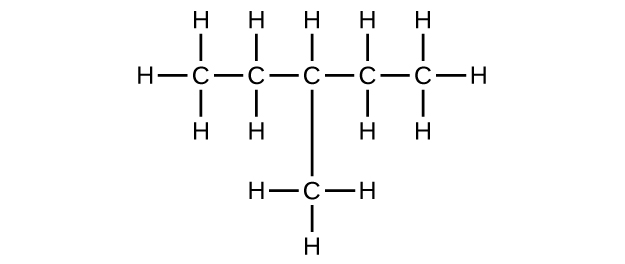 ;
;
(c) [latex]\text{C}_6\text{H}_{12}[/latex]
 ;
;
(d) [latex]\text{C}_6\text{H}_{12}[/latex]
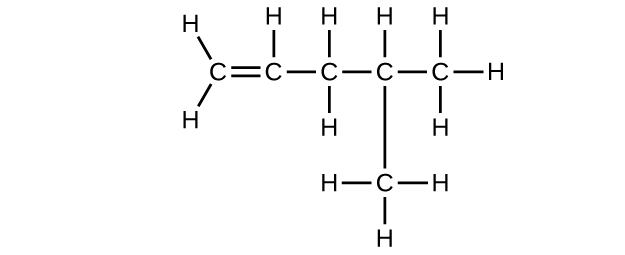 ;
;
(e) [latex]\text{C}_6\text{H}_{ten}[/latex]
 ;
;
(f) [latex]\text{C}_6\text{H}_{10}[/latex]

11. (a) 2,2-dibromobutane; (b) ii-chloro-ii-methylpropane; (c) ii-methylbutane; (d) i-butyne; (due east) four-fluoro-4-methyl-1-octyne; (f) trans-1-chloropropene; (thousand) five-methyl-1-pentene
thirteen.

15.

17. (a) 2,2,four-trimethylpentane; (b) two,two,3-trimethylpentane, 2,3,4-trimethylpentane, and 2,3,three-trimethylpentane:

19.
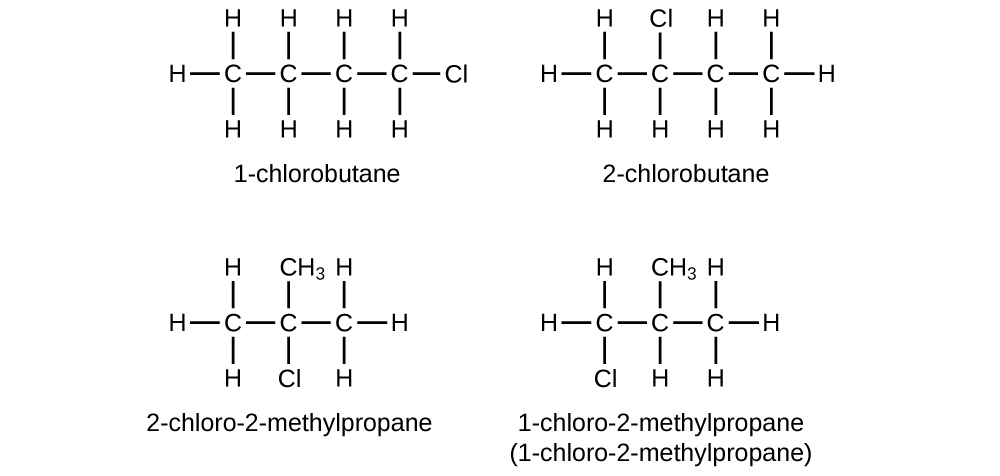
21. In the following, the carbon backbone and the appropriate number of hydrogen atoms are shown in condensed form:
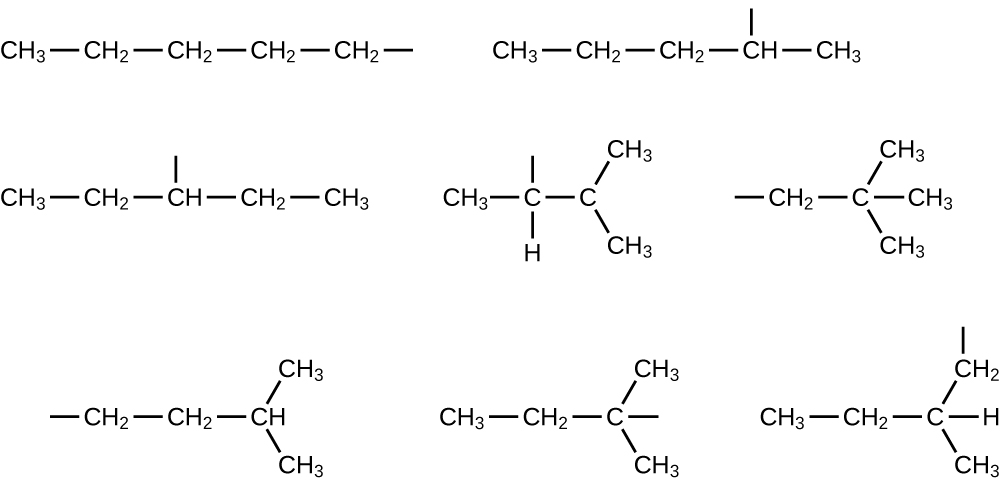
23.
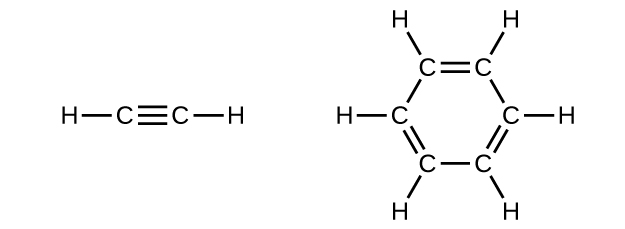
In acetylene, the bonding uses sp hybrids on carbon atoms and southward orbitals on hydrogen atoms. In benzene, the carbon atoms are sp 2 hybridized.
25. (a) [latex]\text{CH}\;{\equiv}\;\text{CCH}_2\text{CH}_3\;+\;2\text{I}_2\;{\longrightarrow}\;\text{CHI}_2\text{CI}_2\text{CH}_2\text{CH}_3[/latex]

(b) [latex]\text{CH}_3\text{CH}_2\text{CH}_2\text{CH}_2\text{CH}_3\;+\;8\text{O}_2\;{\longrightarrow}\;v\text{CO}_2\;+\;vi\text{H}_2\text{O}[/latex]

27. 65.2 g
29. 9.328 × x2 kg
Source: https://opentextbc.ca/chemistry/chapter/20-1-hydrocarbons/